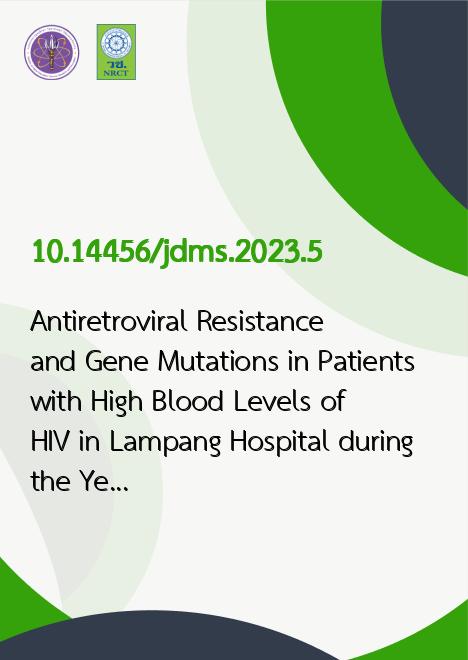
|
Antiretroviral Resistance and Gene Mutations in Patients with High Blood Levels of HIV in Lampang Hospital during the Year 2020-2021 |
|---|---|
| รหัสดีโอไอ | |
| Creator | Sawat Chantawong |
| Title | Antiretroviral Resistance and Gene Mutations in Patients with High Blood Levels of HIV in Lampang Hospital during the Year 2020-2021 |
| Publisher | สำนักวารสารกรมการแพทย์ |
| Publication Year | 2566 |
| Journal Title | Journal of the Department of Medical Services |
| Journal Vol. | 48 |
| Journal No. | 1 |
| Page no. | 44-50 |
| Keyword | Antiretroviral drug, gene mutation, drug resistance |
| URL Website | https://he02.tci-thaijo.org/index.php/JDMS |
| Website title | วารสารกรมการแพทย์ |
| ISSN | 2697-6404 |
| Abstract | Background: HIV patients need antiretroviral therapy, which can inhibit the proliferation of the virus, fortreatment. However, inconsistent medication use or the widespread use of antiviral medications can lead to antiviralresistance. Objective: To determine the rate of HIV drug resistance and gene mutation that causes antiretroviralresistance in patients at Lampang Hospital. Methods: Retrospective study were collected for antiretroviral drugresistance testing from 1 January 2020 to 31 December 2021 from 477 patients with HIV viral load greater than1,000 copies/ml. 108 cases were considered by physician for antiretroviral drug resistance testing and collecteddata on mutated gene testing. Results: From 108 patients tested for antiretroviral drug resistance, 83 were foundto be resistant to antiretroviral drugs in the nucleoside reverse transcriptase inhibitors (NRTIs), non- nucleosidereverse transcriptase inhibitors (NNRTIs) and protease inhibitors (PIs) groups. 67 patients were tested for genemutations of NRTIs gene. It was found that the most mutated position was M184V, which was found in 40patients, followed by D67N in 22 patients. The rate of resistance to Emtricitabine and Lamivudine was 51 casesfor each mutated position. For NNRTIs gene mutation test, the most mutated position was K103N, which wasfound in 29 patients, followed by Y181C in 20 patients. 61 cases were found to be resistant to Efavirenz, and60 for Navirapine. As for the Pls group, the mutation position was M46I, which was found in 3 patients. 2 caseswere found to be resistant to Indinavir. However, this study found that there was no drug resistance in integrasestrand transfer inhibitors (INSTIs). Conclusions: Patients with high blood levels of HIV in Lampang Hospital showeddrug resistance in NRTIs, NNRTIs and PIs, with the most concomitant drug resistance among NRTIs+ NNRTIs. No drugresistance was found in INSTIs. |